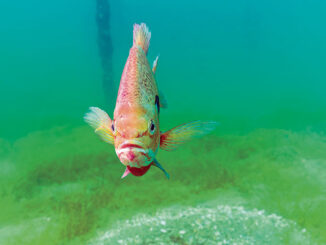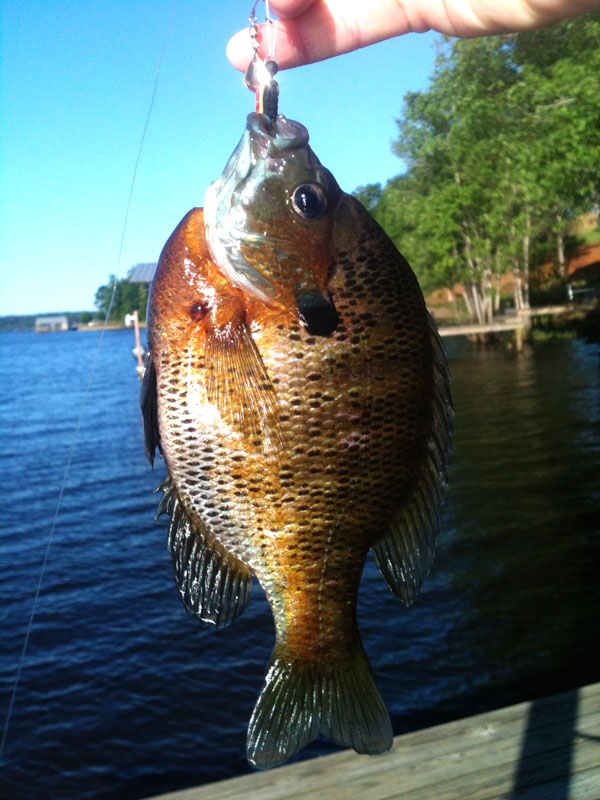 Target these six specific kinds of cover that bream use, and you’ll fill that stringer up in no time.
Target these six specific kinds of cover that bream use, and you’ll fill that stringer up in no time.
The whirlwind evolution of fishing innovation over the past decade has been hard to keep up with. New baits, new electronics, new gear. It has been mind blowing.
But bream fishing? Bream fishing has pretty much remained, well, it’s still just bream fishing.
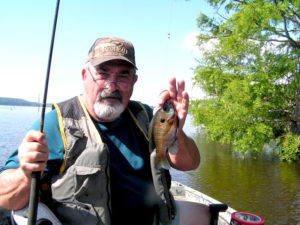
If you fish for pure pleasure and to stack up an ice chest full of tasty bream for supper, it remains a simple pleasure. And the lures and techniques have remained pretty much the same over decades. That’s one of the pleasures.
But you can do a few things to ramp up your success and pleasure. It doesn’t cost any more, doesn’t require any special gear — just a little more effort. Just pay a bit more attention to where you drop your hook, line and sinker. Target places to put your bait and hit the bull’s-eye; don’t just pitch and wish. You can even catch bream from the bank or a boat dock looking for this type of structure.
When you are serious about bream fishing, you need to stay on target. Study the area you’re fishing and pick out the best types of structure to fish; Don’t just toss your cricket into a random spot. Target your casts and bobber placement the way you would fishing for bass or crappie. Pay attention to where you catch them — and where you don’t. Developing a pattern for what the bream are doing will help you minimize your wasted fishing time and maximize your catch.
Here are six types of spots to look for to put the bull’s-eye on bream this spring and summer:
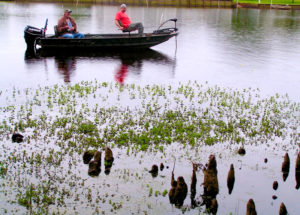
Bream beds
You can’t always see bream beds; sometimes, you have to search for them with a cricket or worm. Look for places just a few yards off the bank and open areas between trees and grass. If you pay attention, you may have a hidden talent like Randy Tucker of Farmville, who can smell a bream bed in shallow water 10 yards away. It’s just a faint fishy smell, but if you are paying attention, you know you are within fishing distance of a bed. Don’t just assume it’s a dead gar floated up on the bank.
Bream like sandy or gravel bottoms, and they want a place where the sun shines on the beds. Tucker said bream bed, to some degree, on every full moon through spring and into summer on most lakes when water and weather conditions are right.
Boat docks and piers
Boat docks and piers are hardly ever just boat docks and piers. Many owners of such structures also position things under and around piers or docks to attract fish: old Christmas trees, wooden pallets, cinder blocks with PVC pipes stuck in concrete — almost anything. They are great places for tiny baitfish to hide and therefore, great places for bream to feed. Algae also grows on these items, and bream can feed on it. Several brands of man-made, fish-holding structures are available, and more people are putting them out. Pay attention when you are fishing to visible signs of these structure.
Fish all the pilings that support the dock or pier. Fish from the bottom up. Sometimes, fish stay on the bottom and other times they suspend over the structure.
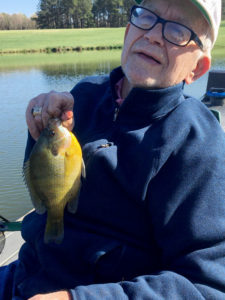
Brush piles, fallen trees
Mother Nature takes care of her own, and these types of spots are a haven for fish activity. Bream love to get in the edges of brush piles and the limbs of fallen trees around the shoreline. When fishing these, start on the outside and work your way in. That way you don’t spook any fish, and you can figure out where they are located. This is a good place to “pattern” bream. If the fish are on the end of one treetop, there’s a good bet that’s where they will be on any treetops that you fish that day.
Cypress trees, stumps
Fish don’t usually gang up in big bunches around live trees and stumps, but you can find some of the best bream in these spots. Again, if you are in 5 feet of water, start out shallow and fish the stump all the way down to the bottom to try and locate fish. Remember, cypress trees have massive root systems, so don’t just fish right by the tree, but anywhere within a couple of feet around it.
Grass beds
Grass shrimp, crawfish and other small creatures are favorite foods of bream. Some of the favorite spots to find these are the edges of or holes of grass beds. Bream also bed in open areas of a grass bed. Fishermen should never pass up a good-looking grass bed. Lily pad fields also hold bream. Bream can often feed off the bottom of lily pads, and if you’ll pay attention, you’ll hear little popping sounds and see lily pads move slightly. That usually signals a bream under there. If there’s an opening between pads, there’s an easy bite waiting for you.
Banks
If you don’t have fancy electronics and are new to a body of water, there’s no better money spot for bream than the bank. Just pick a good-looking one and head down the shoreline. Look for the kinds of structure that hold bream, and if the water is shallow, don’t hesitate to fish on both sides of the boat.
While you are covering ground, take note of what other fishermen are doing. If they’re catching fish, it’s okay to mimic what they are doing.
Technology bump
While all this is fairly basic, Tucker said there is one thing that new technology has given bream fishermen.
“If you have a depth finder with side-imaging, you can ease up and down an area, and you’ll be astounded at how easy it is to spot areas with a bunch of bream beds on the sonar,” he said. “There can be areas where you spot 20 to 30 little circles on the bottom. Those are beds. And while you can’t see the fish on them, you can bet they are there.”
Bream bed and breakfast
Even though fishing for bream is the most basic of fishing pursuits, you can still take a few steps to kick up your bream-busting efforts, including making your own bream beds. If you live on a lake that has regular drawdowns like Farmville’s Randy Tucker, it is best to do that when the lake is lowered.
Simply build a 2×6 or 4×6 wooden frame out of 1×4 lumber and place it on the bottom of the lake. Fill it 3 to 4 inches deep with pea gravel, and let nature take it’s course. The best depth of water is between 3 to 4 feet deep.
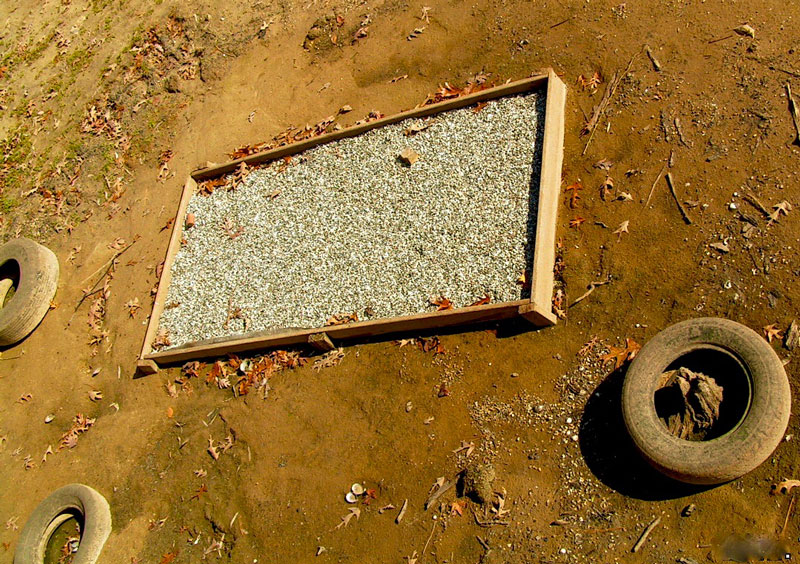
“Bream love to bed up where there is a little gravel,” he said. “It’s a great place to build nests and for bream to feed.”
If you want to enhance a spot when the lake isn’t low, you can take several of bags of pea gravel — you can buy them at any local home-improvement store — and dump them in an area where bream like to hang out. You’ll be surprised how quickly the bream come to those spots.
Another thing that never changes
The technological advances in the development of fillet knives have been good, but for a fisherman who grew up eating fish the “old fashioned way,” a fillet knife isn’t needed.
Randy Tucker is one of those guys. Give him a teaspoon and a sharp pocket knife, and he’s got all he needs to get a mess of bream ready for the skillet.
Whole, fried bream. It’s a culinary prize that fishermen have long enjoyed and still enjoy today.
“When you fry a whole bream, you can eat the crispy tail and fins, gently break apart the fish and eat the meat right off the bone. It’s the tastiest thing out there,” Tucker said. “You know what they say: the nearer the bone, the sweeter the meat. That’s true for eating fish, too.”

If you’ve never eaten whole, fried bream, give Tucker said to give it a try. You can eat the crunchy part of the tail, then break off the rest; remove the fins and the place your thumbs in the fish’s cavity and gently pull it apart. The meat should easily separate from the bones for your enjoyment.
A word of caution: always be on the lookout for small bones, especially around the rib cages.
